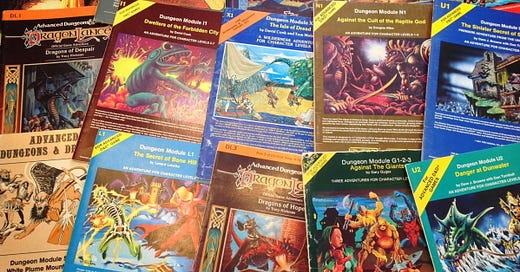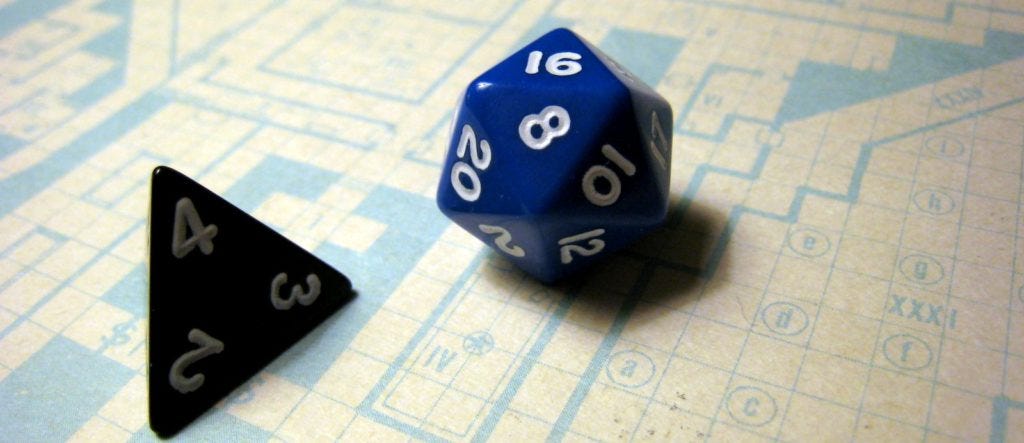Top 8 Classic D&D Modules from the "Advanced" Dungeons and Dragons Era
While modern D&D puts a lot of emphasis on roleplaying and storytelling, the classic "Advanced Dungeons and Dragons" books and modules were as much about being a strategic wargame featuring tactical battles as they were about story and characters. Modules these days come in thick books with extensive background notes and beautifully laid out plots, while Modules in the early days contained on minimal information beyond a map and room descriptions.
We've come a long way.
And yet, many of those old modules really stand the test in time as far as all-time great modules go. In this list, we'll define classic pre-Forgotten Realms and pre-Dragonlance. There are a lot of great Forgotten Realms modules, and Dragonlance was so popular it spawned dozens of books and an entire campaign world, but we'll consider the era before those settings to be the 'Classic' era of D&D adventures.
White Plume Mountain
White Plume Mountain takes place in a geyser-spewing mountain with the quest for a trident named Wave, a war hammer named Whelm and a sword named Blackrazor. The sword is often compared to Elric's Stormbringer and makes an appearance in Baldur's Gate II: Shadows of Amn.
While not as trap-heavy as a certain other classic D&D module, White Plume Mountain had a good balance between traps and the normal encounters expected in a dungeon crawl. It also introduced a lot of cool mechanics such as dodging erupting geysers while navigating platforms during a battle against enemies or fighting a vampire in a room with magical darkness.
Expedition to Barrier Peaks
A great example of mashing together science fiction and fantasy, much of this modules takes place on a crashed spaceship. Strange aliens. Laser-shooting robots. And no doubt, the inspiration behind similar themes found in the Might and Magic CRPGs.
The module contains a lot of great environmental aspects such a food-serving robot and a medical robot. It also hosts some vegepygmies, which some believe are among the worst monsters ever to be inserted into D&D. At the time of the module, vegepygmies were pretty rare, making them an interesting find on the spaceship.
Caste Amber
While I played through most of the modules on this list back when they were "current" rather than "classic," Castle Amber is one that I only DM'd. After my first read through, I deemed it as one of the most unsolvable modules but a total must-do for any set of adventurers wishing to have a lot of fund.
The module itself was very Edgar Allen Poe. There's a boxing match, an ogre who thinks he's a human female and an entire other world to become trapped within... *cough*... to explore.
Against the Giants
A truly classic dungeon crawl, the G series starts with Steading of the Hill Chief, proceeds to Glacial Rift of the Frost Giant Jarl and ends with Hall of the Fire Giant King. These modules may be some of the best remembered by those who experienced them, so if you ever get trapped in a room with an old player who uses the phrase, "Back in my day...", be prepared to hear about the giants.
Against the Giants weren't the only connected series of modules, but they were definitely among the best. They featured a nice progression for the players, and while there were a lot of giants, there was plenty of other variety (and loot) to entertain the players. The storyline also continues in the D-series modules where the players meet the kuo-to and the drow.
Ravenloft
Ravenloft is known as a great campaign setting, but before it was an entire world, it was a module. The story was written by Tracy and Laura Hickman. Tracy Hickman went on to co-auther the Dragonlance series of modules and books. Centered around the vampire Strahd, Ravenloft had some interesting random elements such as the location of key magical weapons. Strahd has gone on to star in a rather good novel and Ravenloft has become an epic setting.
Fun fact: Lord Soth, the epic death knight from Dragonlance, appears in Ravenloft and rules the land of spectres.
Descent into the Depths/Queen of the Demonweb Pits
R. A. Salvatore may have both popularized the drow and then drove the idea of a drow character, especially a drow ranger, into the ground. But before Salvatore got his hands on the, drow elves hung out in an area of the Underdark reached through the Descent into the Depths and ruled over by Lolth, a spider-queen demi-god.
Continuing the story from Against the Giants, The D-series of modules eventually lead the players to the Queen of the Demonweb Pits. Spoiler alert: Yes, you may end up fighting that demi-god. This may be the most epic battle in any of the classic modules and has sometimes been hailed as the best module of all time. Obviously, it makes this list, but I wouldn't quite put it up there even with these last two modules.
The Temple of Elemental Evil
Most players began the adventure toward the Temple of Elemental Evil with a fresh batch of newbie level 1 characters and a module called the Village of Homlet. In fact, many might argue that the Village of Homlet deserves its own place on this list, and while I can't quite rank it alongside many of these great modules, it does provide a great template for what makes a fun setting. There's a village, a lot of interesting and powerful characters, an old keep provides a great adventure area and a lurking powerful Elemental Evil sets the tone. It's not just a great introducing for new characters, it makes a great starter module for new players.
After the Village of Homlet, the now-more-experienced characters begin delving into the dungeons beneath the temple where Zuggtmoy, Demon Queen of the Fungi, is trapped. This sets up a series of three dungeon-crawling adventures that culminate into one of the most popular module series of all time.
The Temple of Elemental Evil also makes its way into board game format similar to the Wrath of Ashardalon. These board games create a more simplified version of D&D that focus more on strategy and can be played over the course of a half-hour.
Tomb of Horrors
I remember the horror I experienced when I found out that the Foundation series won out in Hugo's Best Series of All Time, somehow beating out The Lord of the Rings. The award was given out in 1966, so you won't see either of those battlign it out against George R. Martin's behemoth, but how could Foundation win of THE blueprint for high fantasy? Don't get me wrong, I loved the Foundation series, but it's not exactly become a blueprint for an entire genre to follow for decades and decades.
How did it win? I imagine the award winners didn't want to go with the popular choice.
I can understand. It would be easy to not choose the Tomb of Horrors just because many people expect it to top these lists. In fact, some people have called it among the worst modules of all time because of its cruelty to players. (I.e. it's pretty easy for characters to die, and when that death involved being enveloped in green slime, it's a quite permanent death. Thusly, I lost my favorite thief....)
While there are around 30 rooms and encounter areas to experience, there are only just over a dozen that actually have monsters to fight. The Tomb of Horrors isn't about whipping out that fireball spell or drawing your +4 long sword, defender. It's about using your head to stay alive.
And that's hard. The final battle is one of the most difficult in D&D history, but the tricks and traps that lead up to it are what make this module epic.
It is the epitome of a dungeon that is trying to kill the characters.
Want to play through some of these modules using a modern RPG? Check out Classic Modules Today, a website dedicated to converting some of these modules.




